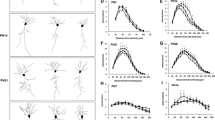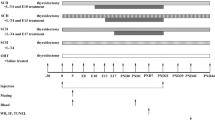Abstract
Iodine deficiency (ID)-induced thyroid hormone (TH) insufficient during development leads to impairments of brain function, such as learning and memory. Marginal ID has been defined as subtle insufficiency of TH, characterized as low thyroxine (T4) levels, whether marginal ID potentially had adverse effects on the development of hippocampus and the underlying mechanisms remain unclear. Thus, in the present study, we established Wistar rat models with ID diet during pregnancy and lactation. The effects of marginal ID on long-term potentiation (LTP) were investigated in the hippocampal CA1 region. To study the development of dendritic spines in pyramidal cells, Golgi-Cox staining was conducted on postnatal day (PN) 7, PN14, PN21, and PN28. The activation of Rac1 signaling pathway, which is essential for dendritic spine development by regulating actin cytoskeleton, was also investigated. Our results showed that marginal ID slightly reduced the field-excitatory postsynaptic potential (f-EPSP) slope and the population spike (PS) amplitude. Besides, the density of dendritic spines during the critical period of rat postnatal development was mildly decreased, and we found no significant change of spine morphology in marginal ID group. We also observed decreased activation of the Rac1 signaling pathway in pups subjected to maternal marginal ID. Our study may support the hypothesis that decreased T4 induced by marginal ID results in slight impairments of LTP and leads to mild damage of dendritic spine development, which may be due to abnormal regulation of Rac1 signaling pathway on cytoskeleton.







Similar content being viewed by others
References
Patel J, Landers K, Li H, Mortimer RH, Richard K (2011) Thyroid hormones and fetal neurological development. J Endocrinol 209(1):1–8
World Health Organization/UNICEF/ICCIDD (2007) Assessment of ID disorders and monitoring their elimination: a guide for programme managers, 3rd edn. World Health Organization, Geneva. Available from http://whqlibdoc.who.int/publications/2007/9789241595827_eng.pdf
Melse-Boonstra A, Jaiswal N (2010) Iodine deficiency in pregnancy, infancy and childhood and its consequences for brain development. Best Pract Res Clin Endocrinol Metab 24(1):29–38
Min H, Dong J, Wang Y, Wang Y, Teng W, Xi Q, Chen J (2015) Maternal hypothyroxinemia-induced neurodevelopmental impairments in the progeny. Mol Neurobiol. doi:10.1007/s12035-015-9101-x
Wang Y, Wang Y, Dong J, Wei W, Song B, Min H et al (2014) Developmental hypothyroxinemia and hypothyroidism reduce proliferation of cerebellar granule neuron precursors in rat offspring by downregulation of the sonic hedgehog signaling pathway. Mol Neurobiol 49(3):1143–1152
Méndez-Villa L, Elton-Puente JE, Solís-S JC, Sampson-Zaldívar E, García-G C et al (2014) Iodine nutrition and thyroid function assessment in childbearing age women from Queretaro, Mexico. Nutr Hosp 29(1):204–211
Ferreira SM, Navarro AM, Magalhães PK, Maciel LM (2014) Iodine insufficiency in pregnant women from the State of São Paulo. Arq Bras Endocrinol Metabol 58(3):282–287
Zimmermann MB, Gizak M, Abbott K, Andersson M, Lazarus JH (2015) Iodine deficiency in pregnant women in Europe. Lancet Diabetes Endocrinol 3(9):672–674
Willoughby KA, McAndrews MP, Rovet JF (2014) Effects of maternal hypothyroidism on offspring hippocampus and memory. Thyroid 24(3):576–584
Wheeler SM, McLelland VC, Sheard E, McAndrews MP, Rovet JF (2015) Hippocampal functioning and verbal associative memory in adolescents with congenital hypothyroidism. Front Endocrinol 6:163
Greenhill SD, Juczewski K, de Haan AM, Seaton G, Fox K, Hardingham NR (2015) Adult cortical plasticity depends on an early postnatal critical period. Science 349(6246):424–427
Calabrese B, Wilson MS, Halpain S (2006) Development and regulation of dendritic spine synapses. Physiology 21:38–47
Bourne JN, Harris KM (2008) Balancing structure and function at hippocampal dendritic spines. Annu Rev Neurosci 31:47–67
Hutsler JJ, Zhang H (2010) Increased dendritic spine densities on cortical projection neurons in autism spectrum disorders. Brain Res 1309:83–94
Takashima S, Becker LE, Armstrong DL, Chan F (1981) Abnormal neuronal development in the visual cortex of the human fetus and infant with down’s syndrome. A quantitative and qualitative Golgi study. Brain Res 225(1):1–21
Galvez R, Greenough WT (2005) Sequence of abnormal dendritic spine development in primary somatosensory cortex of a mouse model of the fragile X mental retardation syndrome. Am J Med Genet A 35(2):155–160
Irwin SA, Galvez R, Greenough WT (2000) Dendritic spine structural anomalies in fragile-X mental retardation syndrome. Cereb Cortex 10(10):1038–1044
Bellot A, Guivernau B, Tajes M, Bosch-Morato M, Valls-Comamala V, Muñoz FJ (2014) The structure and function of actin cytoskeleton in mature glutamatergic dendritic spines. Brain Res 1573:1–16
Fukazawa Y, Saitoh Y, Ozawa F, Ohta Y, Mizuno K, Inokuchi K (2003) Hippocampal LTP is accompanied by enhanced F-actin content within the dendritic spine that is essential for late LTP maintenance in vivo. Neuron 38(3):447–460
Hall A, Nobes CD (2000) Rho GTPases: molecular switches that control the organization and dynamics of the actin cytoskeleton. Philos Trans R Soc Lond B Biol Sci 355(1399):965–970
Schratt G (2009) microRNAs at the synapse. Nat Rev Neurosci 10(12):842–849
Haeckel A, Ahuja R, Gundelfinger ED, Qualmann B, Kessels MM (2008) The actin-binding protein Abp1 controls dendritic spine morphology and is important for spine head and synapse formation. J Neurosci 28(40):10031–10044
Stankiewicz TR, Linseman DA (2014) Rho family GTPases: key players in neuronal development neuronal survival, and neurodegeneration. Front Cell Neurosci 8:314
Luo LQ (2000) Rho GTPases in neuronal morphogenesis. Nat Rev Neurosci 1(3):173–180
Govek EE, Newey SE, Van Aelst L (2005) The role of the Rho GTPases in neuronal development. Genes Dev 19(1):1–49
Reeves PG, Nielsen FH, Fahey GC Jr (1993) AIN-93 purified diets for laboratory rodents: final report of the American Institute of Nutrition ad hoc writing committee on the reformulation of the AIN-76A rodent diet. J Nutr 123(11):1939–1951
Paxions G, Watson C (1996) The rat brain in stereotaxic coordinates. Academic Press, Sydney, pp 21–28
Norrholm SD, Ouimet CC (2000) Chronic fluoxetine administration to juvenile rats prevents age-associated dendritic spine proliferation in hippocampus. Brain Res 883(2):205–215
Arellano JI, Benavides-Piccione R, Defelipe J, Yuste R (2007) Ultrastructure of dendritic spines: correlation between synaptic and spine morphologies. Front Neurosci 1(1):131–143
Dong J, Lei X, Wang Y, Wang Y, Song H, Li M et al (2015) Different degrees of iodine deficiency inhibit differentiation of cerebellar granular cells in rat offspring via BMP-Smad1/5/8 Signaling. Mol Neurobiol. doi:10.1007/s12035-015-9382-0
Sekino Y, Kojima N, Shirao T (2007) Role of actin cytoskeleton in dendritic spine morphogenesis. Neurochem Int 51(2-4):92–104
Yang N, Higuchi O, Ohashi K, Nagata K, Wada A, Kangawa K, Nishida E, Mizuno K (1998) Cofilin phosphorylation by LIM-kinase 1 and its role in Rac-mediated actin reorganization. Nature 393(6687):809–812
Mikati MA, Grintsevich EE, Reisler E (2013) Drebrin-induced stabilization of actin filaments. J Biol Chem 288(27):19926–19938
Edwards DC, Sanders LC, Bokoch GM, Gill GN (1999) Activation of LIM-kinase by Pak1 couples Rac/Cdc42 GTPase signalling to actin cytoskeletal dynamics. Nat Cell Biol 1(5):253–259
Boda B, Nikonenko I, Alberi S, Muller D (2006) Central nervous system functions of PAK protein family: from spine morphogenesis to mental retardation. Mol Neurobiol 34(1):67–80
Nadif Kasri N, Van Aelst L (2008) Rho-linked genes and neurological disorders. Pflugers Arch 455(5):787–797
Hall A (1998) Rho GTPases and the actin cytoskeleton. Science 279(5350):509–514
Watutantrige Fernando S, Cavedon E, Nacamulli D, Pozza D, Ermolao A, Zaccaria M et al (2015) Iodine status from childhood to adulthood in females living in North-East Italy: iodine deficiency is still an issue. Eur J Nutr. doi:10.1007/s00394-015-0853-x
Sareen N, Pradhan R (2015) Need for neonatal screening program in India: a national priority. Indian J Endocrinol Metab 19(2):204–220
Abbag FI, Abu-Eshy SA, Mahfouz AA, Al-Fifi SA, El-Wadie H, Abdallah SM et al (2015) Iodine-deficiency disorders in the Aseer region, south-western Saudi Arabia: 20 years after the national survey and universal salt iodization. Public Health Nutr 18(14):2523–2529
Zimmermann MB, Andersson M (2012) Update on iodine status worldwide. Curr Opin Endocrinol Diabetes Obes 19(5):382–387
Navarro D, Alvarado M, Navarrete F, Giner M, Obregon MJ, Manzanares J et al (2015) Gestational and early postnatal hypothyroidism alters VGluT1 and VGAT bouton distribution in the neocortex and hippocampus, and behavior in rats. Front Neuroanat 9:9
Wang Y, Wei W, Wang Y, Dong J, Song B, Min H, Teng W, Chen J (2013) Neurotoxicity of developmental hypothyroxinemia and hypothyroidism in rats: impairments of long-term potentiation are mediated by phosphatidylinositol 3-kinase signaling pathway. Toxicol Appl Pharmacol 271(2):257–265
Wang Y, Wei W, Song B, Wang Y, Dong J, Min H, Chen J (2014) Developmental hypothyroxinemia caused by mild iodine deficiency leads to HFS-Induced LTD in Rat Hippocampal CA1 region: involvement of AMPA receptor. Mol Neurobiol 50(2):348–357
Grossman AW, Aldridge GM, Weiler IJ, Greenough WT (2006) Local protein synthesis and spine morphogenesis: fragile X syndrome and beyond. J Neurosci 26(27):7151–7155
Lüscher C, Nicoll RA, Malenka RC, Muller D (2000) Synaptic plasticity and dynamic modulation of the postsynaptic memebrane. Nat Neurosci 3(6):545–550
Nimchinsky EA, Oberlander AM, Svoboda K (2001) Abnormal development of dendritic spines in FMR1 knock-out mice. J Neurosci 21(14):5139–5146
Tada T, Sheng M (2006) Molecular mechanisms of dendritic spine morphogenesis. Curr Opin Neurobiol 16(1):95–101
Ethell IM, Pasquale EB (2005) Molecular mechanisms of dendritic spine development and remodeling. Prog Neurobiol 75(3):161–205
Schafer DA (2002) Coupling actin dynamics and membrane dynamics during endocytosis. Curr Opin Cell Biol 14(1):76–81
Priel A, Tuszynski JA, Woolf NJ (2010) Neural cytoskeleton capabilities for learning and memory. J Biol Phys 36(1):3–21
Siegrist-Kaiser CA, Juge-Aubry C, Tranter MP, Ekenbarger DM, Leonard JL (1990) Thyroxine-dependent modulation of actin polymerization in cultured astrocytes. A novel, extranuclear action of thyroid hormone. J Biol Chem 265(9):5296–5302
Leonard JL, Farwell AP (1997) Thyroid hormone-regulated actin polymerization in brain. Thyroid 7(1):147–151
Farwell AP, Dubord-Tomasetti SA, Pietrzykowski AZ, Stachelek SJ, Leonard JL (2005) Regulation of cerebellar neuronal migration and neurite outgrowth by thyroxine and 3,3′,5′-triiodothyronine. Brain Res Dev Res 154(1):121–135
Zamoner A, Funchal C, Jacques-Silva MC, Gottfried C, Barreto Silva FR, Pessoa-Pureur R (2007) Thyroid hormones reorganize the cytoskeleton of glial cells through Gfap phosphorylation and Rhoa-dependent mechanisms. Cell Mol Neurobiol 27(7):845–865
Davis PJ, Leonard JL, Davis FB (2008) Mechanisms of nongenomic actions of thyroid hormone. Front Neuroendocrinol 29(2):211–218
Soria Fregozo C, Perez Vega MI (2012) Actin-binding proteins and signalling pathways associated with the formation and maintenance of dendritic spines. Neurologia 27(7):421–431
Ivanov A, Esclapez M, Ferhat L (2009) Role of drebrin A in dendritic spine plasticity and synaptic function: implications in neurological disorders. Commun Integr Biol 2(3):268–270
Counts SE, He B, Nadeem M, Wuu J, Scheff SW, Mufson EJ (2012) Hippocampal drebrin loss in mild cognitive impairment. Neurodegener Dis 10(1-4):216–219
Bamburg JR (1999) Proteins of the ADF/cofilin family: essential regulators of actin dynamics. Annu Rev Cell Dev Biol 15:185–230
Sarmiere PD, Bamburg JR (2002) Head, neck, and spines: a role for LIMK-1 in the hippocampus. Neuron 35(1):3–5
Cheng SY, Leonard JL, Davis PJ (2010) Molecular aspects of thyroid hormone actions. Endocr Rev 31(2):139–170
Zamoner A, Pessoa-Pureur R (2011) Nongenomic actions of thyroid hormones: every why has a wherefore. Immunol Endocr Metab Agents Med Chem 11:165–178
Davis PJ, Shih A, Lin HY, Martino LJ, Davis FB (2000) Thyroxine promotes association of mitogen-activated protein kinase and nuclear thyroid hormone receptor (TR) and causes serine phosphorylation of TR. J Biol Chem 275(48):38032–38039
Acknowledgments
This work was supported by the National Natural Science Foundation of China (grant numbers 81102126), Important Platform of Science and Technology for the Universities in Liaoning Province (grant number 16010), and Program for Liaoning Innovative Research Team in University (grant number LT2015028).
Author information
Authors and Affiliations
Corresponding author
Ethics declarations
Conflict of Interest
The authors declare no competing financial interests.
Rights and permissions
About this article
Cite this article
Min, H., Dong, J., Wang, Y. et al. Marginal Iodine Deficiency Affects Dendritic Spine Development by Disturbing the Function of Rac1 Signaling Pathway on Cytoskeleton. Mol Neurobiol 54, 437–449 (2017). https://doi.org/10.1007/s12035-015-9657-5
Received:
Accepted:
Published:
Issue Date:
DOI: https://doi.org/10.1007/s12035-015-9657-5




